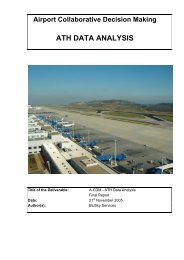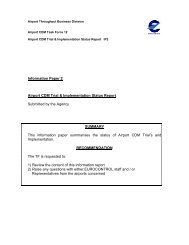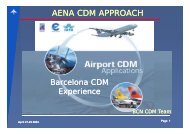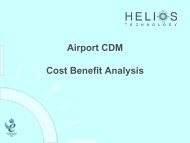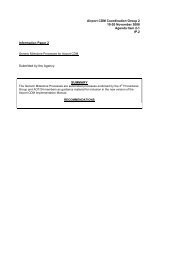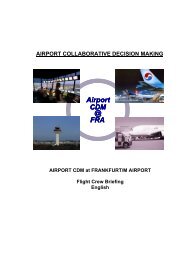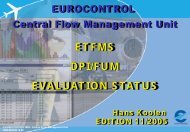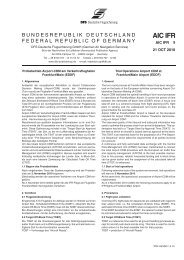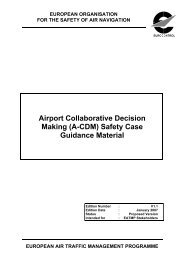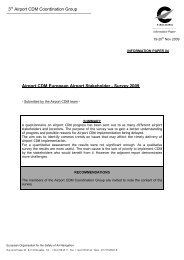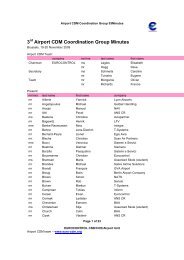Generic Operational Concept for DMAN Interaction v07A - Airport ...
Generic Operational Concept for DMAN Interaction v07A - Airport ...
Generic Operational Concept for DMAN Interaction v07A - Airport ...
You also want an ePaper? Increase the reach of your titles
YUMPU automatically turns print PDFs into web optimized ePapers that Google loves.
<strong>Generic</strong> <strong>Operational</strong> <strong>Concept</strong> <strong>for</strong> Pre-departure Runway Sequence Planning and<br />
Accurate Take-Off Per<strong>for</strong>mance<br />
Enabled by <strong>DMAN</strong> interaction with <strong>Airport</strong> CDM and A-SMGCS concepts<br />
2. GENERIC OPERATIONAL CONCEPT<br />
2.1 Scope<br />
The scope of this generic operational concept focuses on surface movements of aircraft<br />
during the taxi-out phase, which is considered highly dynamic and there<strong>for</strong>e difficult to<br />
predict. Planning and accurately controlled execution of those movements on the<br />
aprons, taxiways, and runways requires an integrated view in order to achieve the<br />
expected benefits listed in section 1.4.2.<br />
This document does not discuss landside planning or airside ground handling traffic<br />
activities, nor does it refer to passenger or cargo flow planning. The document is also<br />
independent of any sequence optimisation methodology, as applied by industrial<br />
companies in their <strong>DMAN</strong> products.<br />
This document has strong interdependency with Arrival Management (AMAN) coupling<br />
to <strong>DMAN</strong> concepts, as well as TMA-ACC traffic flow optimisation, as described in<br />
references 1 and 3 and section 1.4.6. This document <strong>for</strong>ms an essential pre-requisite <strong>for</strong><br />
traffic planning in TMA departure metering, as mentioned in section 1.4.7. Also, there are<br />
dependencies on stand and gate management policies and constraints, as these may be<br />
stressed due this concept of departure management.<br />
2.2 Timeframe<br />
The applicable timeframe <strong>for</strong> this generic concept is defined in SESAR Implementation<br />
Packages (IP). <strong>Airport</strong> CDM and A-SMGCS functions Surveillance and Safety Nets, are<br />
implemented under IP1, and can be validated in operational experiments in near term<br />
projects. More advanced functions in A-SMGCS (see section 1.3.1) are planned <strong>for</strong><br />
implementation in IP2, and can be included in longer term validation activities under<br />
SESAR.<br />
2.3 Objectives<br />
With the scope and timeframe in consideration the concept objectives are derived <strong>for</strong><br />
<strong>DMAN</strong> interaction with <strong>Airport</strong> CDM and A-SMGCS. These concept objectives aim to be<br />
generic <strong>for</strong> any airport that considers implementing pre-departure off-block and runway<br />
sequencing of outbound flights into their operational environment. From these objectives<br />
and the concept that is derived from them, operational requirements can be considered<br />
as high level guidelines <strong>for</strong> implementation.<br />
1. Increase the quality of target take-off times<br />
a. Reduce the deviation from actual take-off compared to target take-off time<br />
b. Increase prediction horizon<br />
c. Enhance robustness of sequence planning against disturbances or<br />
adverse conditions<br />
d.<br />
2. Achieve expected <strong>Airport</strong> CDM and A-SMGCS derived benefits<br />
3. Enhance the reliability of the concepts and technical enablers<br />
a. Demonstrate feasibility of the technical enablers<br />
b. Establish acceptability of take-off sequencing by controllers<br />
Page 10 of 29<br />
EUROCONTROL HQ, Cooperative Network Design, Centre of Expertise, <strong>Airport</strong>s Unit



